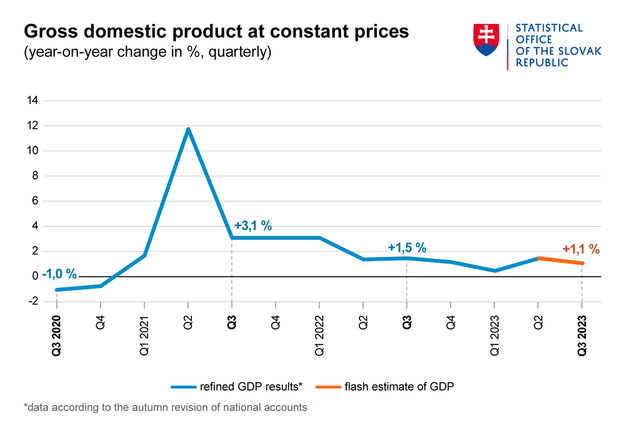The flash estimate of GDP released by the Statistics Office on Tuesday, November 14, brought bad news for Slovakia when its annual growth slowed from 1.5 to 1.1 percent.
On a quarter-on-quarter seasonally adjusted basis, the GDP added just 0.2 percent, Michal Lehuta, macroeconomist at VÚB, noted. He adds that they originally expected an increase by 0.5 percent.
“Thus, even the acceleration in the absorption of EU funds has so far failed to overrun the Europe-wide trend of economic slowdown,” Lehuta wrote in his memo, adding that the eurozone as a whole even recorded a slight quarter-on-quarter decline in GDP (-0.1 percent).
Slovak economic growth was mainly driven by a positive trade balance. Conversely, domestic demand dropped y-o-y due to a persisting slowdown in household final consumption and a drop in inventories.
The Statistics Office will publish definitive GDP figures on December 5, 2023, including structures of individual indicators.
Employment a positive surprise
Total employment in the economy was a positive surprise, growing slightly again despite the slow economic growth (+0.1 percent quarter-on-quarter, +0.2 percent year-on-year).
“So far, the downward trends observed in the monthly statistics for selected private sector industries or for employment contracts in the social security provider Sociálna Poisťovňa have not yet been confirmed,” wrote Lehuta. “However, we anticipate that the decline in economic growth in the coming quarters will also take some bite out of local employment.”
Germany raises concerns
Prospects for the external environment remain worrying for the final quarter of 2023. The reason for the concern are mainly the weak numbers of Germany’s economy, which has long been a key trading partner of Slovak industry.
Next year, UniCredit Bank analyst Ľubomír Koršňák expects a slight recovery in economic growth of around 1.5 percent, with VÚB lowering the annual GDP growth estimate for this year and next year to 1.2 percent in both years. Slovenská Sporiteľňa expects that GDP next year will grow by around 1.3 percent year-on-year, thanks to the expected fiscal stimulus of €5 billion from EU funds.
“The determining factor remains Slovakia’s ability to absorb these resources efficiently and quickly,” said Marián Kočiš, analyst of Slovenská Sporiteľňa.


 Gross domestic product at constant prices (source: Courtesy of teh Statistics Office )
Gross domestic product at constant prices (source: Courtesy of teh Statistics Office )